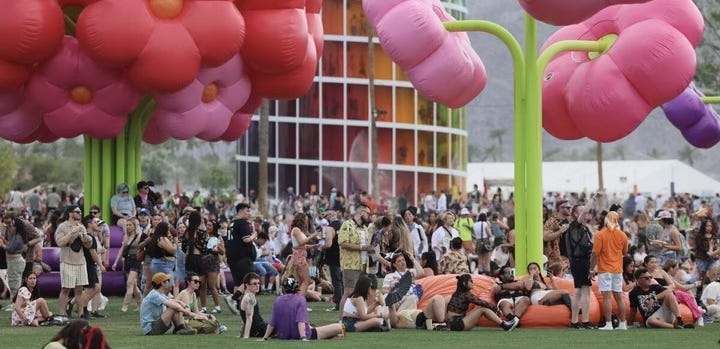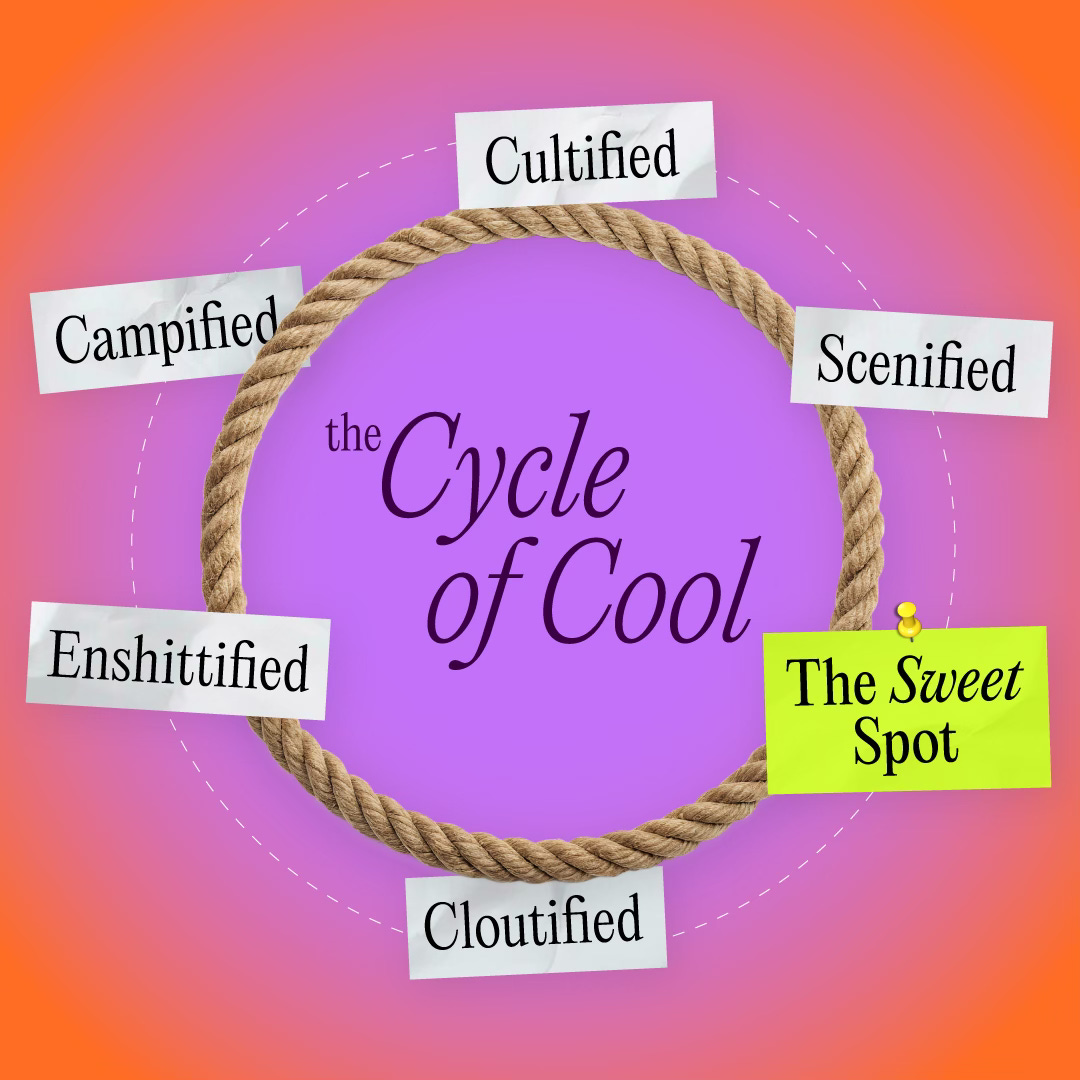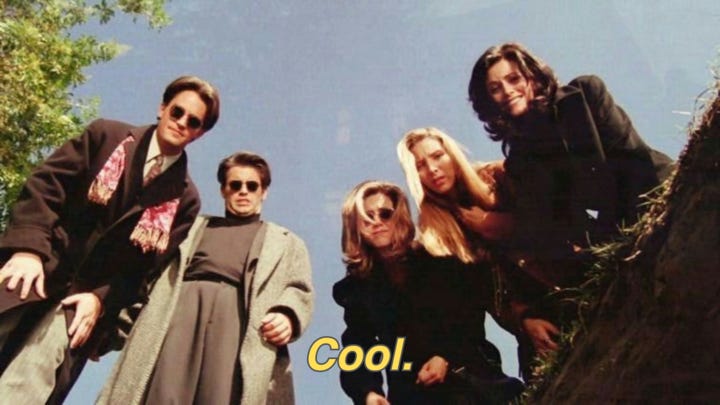Link Lariat: The Cycle of Cool
Instagram makes experiences something you can put on and take off, rather than live.
Howdy friends, curious cultural anthropologists, Substack skimmers, and/or whoever you are that brings you to our corner of the Internet’s opinion deluge! We’re The So What, an 💃 all new Substack 🤩 from the irrefutably genius, culturally-attuned minds of Artemis Ward, the creative agency paving a pathway through the harrowing possibilities of the future. Don’t believe me? Subscribe and we’ll show you.
My name is Ryan, and I’m not only a strategist and writer here at AW — I’m ALSO your host for our monthly 🐎 Link Lariat 🤠, where we corral the internet’s brightest content and lasso out a meaningful epiphany to chew on. This week, in the wake of Coachella, we’re musing about the collision of coolness and content and how it impacts culture. Giddy up!
Recently at the office, we wandered onto the subject of dive bars — the best around our city, what makes a bar a “dive,” and whether a bar can really be both popular and a dive. We decided that “dive bars” are in a unique spot right now, having reached the peak of (what I’m coining) the CYCLE OF COOL.
From dive bars and restaurants to TV shows and content creators to fashion trends and ✨music festivals✨, this cycle has blazed through just about everything over time. Let me show you what I mean with a case study of the infamous Coachella.
Just last week, thousands flocked to the California desert for another round of the world’s biggest spectacle. While it’s ostensibly a music festival, Coachella offers more than just tunes — it’s a brand bash, influencer inferno, fashion frolick, and online obsession. What started as an indie celebration of music is now much more about what’s around the stage than actually on it.
While people might argue where exactly Coachella is at in its coolness, most would agree that the festival has gone beyond its indie origins and golden age of cool. But whether it’s sickeningly popular, just bad, or perhaps…cool again?!…is up for debate. From the many takes I explored (here’s 1, 2, 3, 4, 5, 6, 7, and 8), what I’ve gathered is this: there are still many parts of the festival that feel manufactured, inauthentic, and more aesthetic than experience. But some bits of “Coachella” (in the broadest sense of the term) are starting to embrace nostalgia, normality, and an off-gram atmosphere, whether it’s more “normal” outfit choices that hearken back to earlier styles, influencers and celebrities attending without posting, or the festival’s return to some of its older performers. It’s those little bits — not the algorithmic, photogenic avalanche — that give Coachella hope for future cool.
Which brings us to the framework I present to you today (not yet rigorously scientifically tested, but AW vibe-checked):
Here’s how it works:
CULTIFIED | Every cool [thing] starts as a niche interest, liked by few and unknown to most. The [thing] is cool because no one knows about it.
SCENIFIED | This [thing] gains traction and a scene, with events, fans, and energy. But it’s still small — on an iykyk (”if you know, you know”) basis, cool because only some people are in on it.
THE SWEET SPOT | People in the scene share this cool [thing] and bring in new audiences. Now, the [thing] has garnered just enough awareness that the community and support behind it is solid, but not so much that it’s been fried to bits by the mainstream.
CLOUTIFIED | This is a [thing]’s tipping point, where it has become so cool that the masses overtake it, giving it so much attention that it loses a defined community. It’s still cool, but to enjoy it, you must weather a storm of brand partnerships, crowd overflow, and constant coverage. (I think “popular” dive bars are probably approaching this stage, if they’re not here already.)
ENSHITTIFIED | Eventually, the spotlight becomes too bright: the level of hassle you must endure to enjoy the [thing] eclipses the enjoyment of the [thing] itself.
CAMPIFIED | Once the [thing] is well and truly torched, a select few will ironically reclaim it, usually because it’s so bad that it’s…kinda good? As this group redefines the [thing]’s coolness, they eventually form their own cultural niche — and so the cycle starts anew, on the way to future cool. (Perhaps Coachella is getting here?)
Okay, great, so that’s the cycle. But how do we make sense of it? And how can we use it to keep more [thing]s (read: YOUR [thing]s) cooler for longer? Start by taking a spin through our links of the month:
Enshittification, coined by Cory Doctorow, describes how platforms decay. Doctorow’s framework is about tech, but it has broader cultural applications. In this article, he argues that “if everyone is threatened by enshittification, then everyone has a stake in disenshittification.” The key idea: for sustainable coolness, address audience problems as opposed to just business problems.
In this article, author Kyle Chayka advocates that we “recapture recommendations from recommender systems” that flatten culture by prioritizing engagement (think: the CLOUTIFIED phase). He explains the importance of our intentional cultural exploration — such as engaging with cultified communities 😉 — to develop taste and, essentially, curate new coolness. The verdict: trust your human tastemakers (perhaps, like, a great creative agency? 😇) — not the algorithm.
How can we show that our [thing]s are a bastion of cool in a sea of business-driven, algorithmically-curated [thing]s? The solution might be to make them uglier. Our first link explores whether websites’ design imperfections are driving conversions due to their humanness, trustworthiness, and inherent expectations. Our second link has a similar philosophy: unphotogenic (aka “ungrammable”) spaces signal a real experience, while too much polish is just for the ‘gram. The underlying message: if you can convey your authenticity, you will maintain your cool.
The So What
“Cool” doesn’t come from a camera roll; it comes from the reason behind the photo. And so the lasso I’ll leave with you — and anyone in the business of shaping culture — is this: if you want your [thing] to last (not just trend), design for presence, not performance. Build experiences and spaces that are worth exploring, not just posting. Signal substance. Invite depth. Let your audience co-create, not just consume. Because when some[thing]’s actually cool, people don’t want to just share it — they want to stay in it.
✉️ If you haven’t yet subscribed, click the link below so you don’t miss a [thing].





